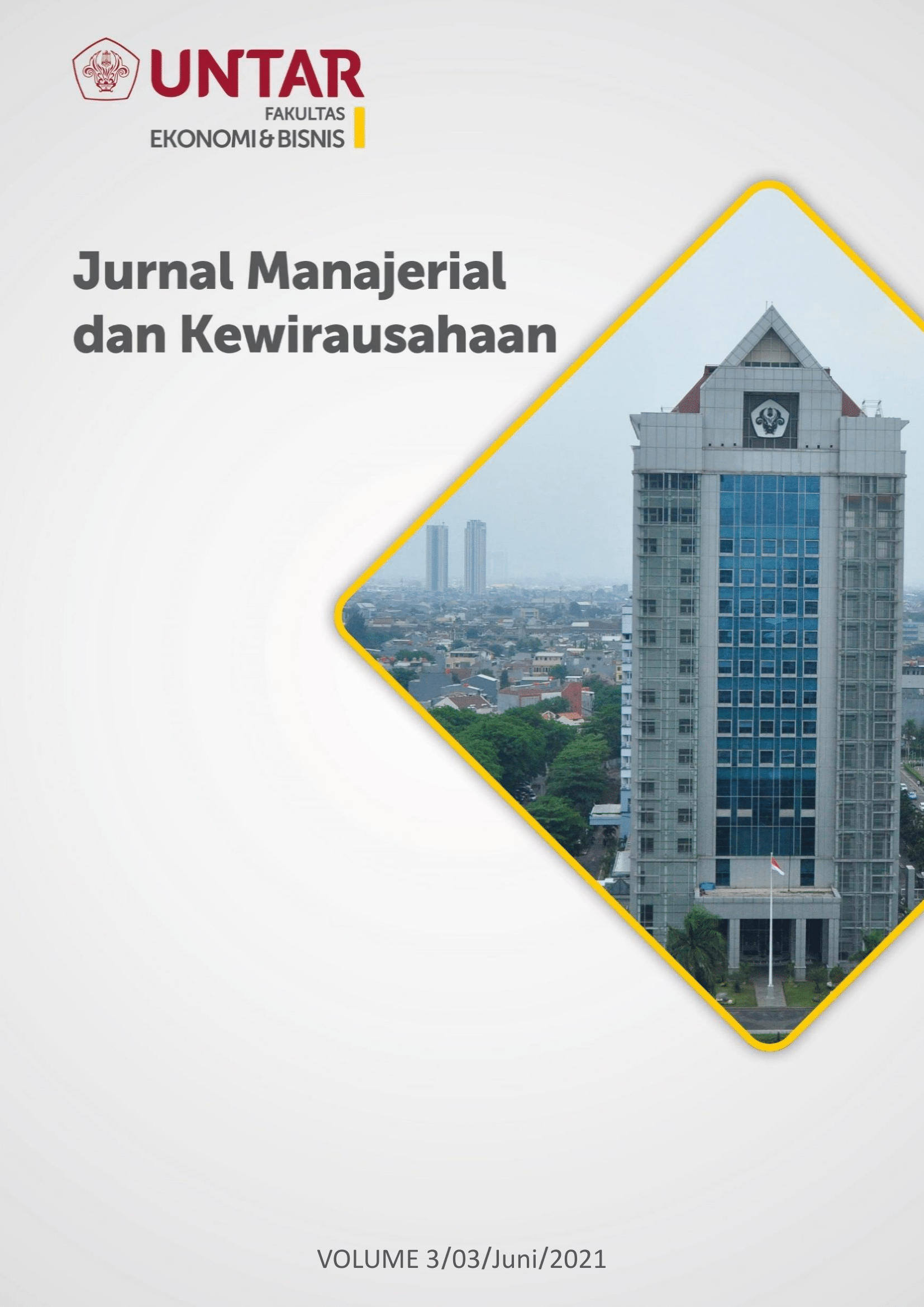Pengaruh Orientasi Kewirausahaan Dan Orientasi Bekelanjutan Terhadap Kewirausahaan Berkelanjutan Dengan Kewirausahaan Bricolage Sebagai Mediasi Pada UKM Di Indonesia
Main Article Content
Abstract
This study aims to determine the interaction of entrepreneurial orientation and sustainable orientation towards sustainable entrepreneurship with bricolage entrepreneurship as a mediation for SMEs in Indonesia. The population in this study were 190 respondents who were owners, managers or executives of SMEs in Indonesia. Sampling in this study using non-probability sampling. The sampling technique in this study is convenience sampling. Data was obtained by distributing questionnaires using google form which was then processed using SmartPLS 3.3.2. The results show that entrepreneurial orientation, sustainable orientation, and entrepreneurial bricolage have a positive effect on sustainable entrepreneurship in Indonesia. Meanwhile, entrepreneurial bricolage has a positive effect in mediating entrepreneurial orientation and sustainable orientation towards sustainable entrepreneurship in Indonesia partially but not significantly.
Penelitian ini bertujuan untuk mengetahui pengaruh orientasi kewirausahaan dan orientasi berkelanjutan terhadap kewirausahaan berkelanjutan dengan kewirausahaan bricolage sebagai mediasi pada UKM di Indonesia. Populasi pada penelitian ini adalah 190 responden yang merupakan pemilik, manajer atau eksekutif UKM yang terdapat di Indonesia. Pengambilan sampel pada penelitian ini menggunakan non-probability sampling. Teknik pemilihan sampel dalam penelitian ini adalah convenience sampling. Data diperoleh dengan menyebarkan kuesioner menggunakan google form yang kemudian diolah menggunakan SmartPLS 3.3.2. Hasil penelitian menunjukkan bahwa orientasi kewirausahaan, orientasi berkelanjutan, dan kewirausahaan bricolage berpengaruh positif terhadap kewirausahaan berkelanjutan di Indonesia. Sedangkan, kewirausahaan bricolage berpengaruh positif dalam memediasi orientasi kewirausahaan dan orientasi berkelanjutan terhadap kewirausahaan berkelanjutan di Indonesia secara partial namun tidak signifikan.
Article Details
This work is licensed under a Jurnal Muara Ilmu Ekonomi dan Bisnis Creative Commons Attribution-ShareAlike 4.0 International License.,/p>
References
Amit, R., Schoemaker, P. J. H., Journal, S. M., & Jan, N. (1993). Strategic Assets and Organizational Rent Strategic Assets and Organizational Rent. December 2017. https://doi.org/10.1002/smj.4250140105
Anderson, B.S., Covin, J.G. and Slevin, D.P. (2009), “Understanding the relationship between entrepreneurial orientation and strategic learning: an empirical investigation”, Strategic Entrepreneurship Journal,Vol.3No.3,pp.219-241
Baker, T., & Nelson, R. E. (2005). Creating something from nothing: Resource construction through entrepreneurial bricolage. Administrative Science Quarterly, 50(3), 329–366. https://doi.org/10.2189/asqu.2005.50.3.329
Barney,J.(1991),“Firm resources and sustained competitive advantage”, Journal of Management, Vol.17 No.1, pp.99-120
Belz, F. M., & Binder, J. K. (2015). Sustainable Entrepreneurship: A Convergent Process Model. https://doi.org/10.1002/bse.1887
Chandler, G.N. and Hanks, S.H. (1994), “Market attractiveness, resource-based capabilities, venture strategies, and venture performance”, Journal of Business Venturing, Vol. 9 No. 4, pp.331-349.
Crals, E. and Vereeck, L. (2004), “Sustainable entrepreneurship in SMEs: theory and practice”, Paper Presented at the 3rd Global Conference on Environmental Justice, Copenhagen
Dacko, S.G., Claudy, M., Garcia, R. and Wilner, S.J. (2013), “Sustainability orientation as a driver of innovation within firms”, Paper Presented at the ISPIM Conference Proceedings, Manchester
Dean, T. J., & McMullen, J. S. (2007). Toward a theory of sustainable entrepreneurship: Reducing environmental degradation through entrepreneurial action. Journal of Business Venturing, 22(1), 50–76.
Gundry, L. K., Kickul, J. R., Griffiths, M. D., & Bacq, S. C. (2011). Creating Social Change Out of Nothing: The Role of Entrepreneurial Bricolage in Social Entrepreneurs’ Catalytic Innovations. In Advances in Entrepreneurship, Firm Emergence and Growth (Vol. 13, Issue 2011). Emerald Group Publishing Ltd. https://doi.org/10.1108/s1074- 7540(2011)0000013005
Hooi, H.C., Ahmad, N.H., Amran, A. and Rahman, S.A. (2016), “The functional role of entrepreneurial orientation and entrepreneurial bricolage in ensuring sustainable entrepreneurship”, Management Research Review, Vol. 39 No. 12, pp. 1616-1638.
IwanPrasodjo, Rita Amelinda, K. N. N. M. (2019). Sustainable Entrepreneurial Intention: The Perceived of Triple Bottom Line among Female Students. Jurnal Manajemen, 23(2), 168. https://doi.org/10.24912/jm.v23i2.472
Kellermanns, F., Walter, J., Crook, T. R., & Kemmerer, B. (2014). The Resource-Based View in Entrepreneurship : A Content-Analytical Comparison of Researchers ’ and Entrepreneurs ’ Views. 1–23. https://doi.org/10.1111/jsbm.12126
Kuckertz, A., & Wagner, M. (2010). Journal of Business Venturing The in fl uence of sustainability orientation on entrepreneurial intentions — Investigating the role of business experience. Journal of Business Venturing, 25(5), 524–539. https://doi.org/10.1016/j.jbusvent.2009.09.001
Miller, D. (1983). The Correlates of Entrepreneurship in Three Types of Firms. May 2014.
Moorthy,M.K.,Yakob,P.,Chelliah,M.K.andArokiasamy,L.(2012),“DriversforMalaysianSMEs to Go Green”, International Journal of Academic Research in Business and Social Sciences, Vol.2No.9,pp.74-86.
Penrose, E. G. (1959).The Theory of the Growth of the Firm. New York: Wiley.
Phillips, N. and Tracey, P. (2007), “Opportunity recognition, entrepreneurial capabilities and bricolage: connecting institutional theory and entrepreneurship in strategic organization”, Strategic Organization, Vol. 5 No. 3, p. 313
Rahman, S. A., Amran, A., & Ahmad, N. H. (2014). GrameenPhone : Creating a Win-Win at the Base of the Pyramid in Bangladesh. August, 41–53. https://doi.org/10.1002/joe
Schaltegger, S., & Wagner, M. (2011). Sustainable Entrepreneurship and Sustainability Innovation: Categories and Interactions. 237(July 2010), 222–237.
Schaper, M. (2002). The challenge of environmental responsibility and sustainable development: Implications for SME and entrepreneurship academics. Radical Change in the World - Will SMEs Soar or Crash?; Umbruch Der Welt - KMU Vor Hohenflug Oder Absturz?, March, 525–534. http://cob.nmu.edu/amtmann/Lavras Course Materials/challenge of environmental responsibility and sustainable developement Implications for SME and entrepreneuship academics 2002.pdf
Sekaran, U., & Bougie, R., (2016). Research Methods for Bussiness A Skill-Building Approach. Printer Trento Srl. Shepherd, D. A. (2011). E T & P The New Field of Entrepreneurship : Sustained ” With “ What Is to Be Developed .” 137–163. https://doi.org/10.1111/j.1540-6520.2010.00426.x Silviasih.
Franky Slamet, Denny Iskandar (2016). Pengaruh Orientasi Pasar Dan Orientasi Kewirausahaan Terhadap Kinerja Usaha Pada Pemilik Ukm Sektor Manufaktur Garmen Di Tanah Abang, Jakarta Pusat. Jurnal Ilmiah Manajemen Bisnis. Vol. 16, No. 1: 13-24
Stam, W. and Elfring, T. (2008), “Entrepreneurial orientation and new venture performance: the moderating role of intra-and extra industry social capital”, Academy of Management Journal, Vol. 51 No. 1, pp. 97-111
Utama, L. and J.K. 2017. Pengaruh Kreatifitas Terhadap Kinerja Usaha Dengan Orientasi Kewirausahaan Sebagai Mediasi Pada Wirausaha di ITC Cempaka Mas. Conference on Managemant and Behavioral Studies. http://cmbs.untar.ac.id/images/prosiding/2017/p/Louis-utama-dan-jeremykristantonadi.pdf.
Diakses Juni, 2020. Wernerfelt,B.(1984),“A resource-based view of the firm”, Strategic Management Journal, Vol.5 No.2, pp.171-180
Wiklund, J. (2006), “The sustainability of the entrepreneurial orientation-performance relationship”, Entrepreneurship and The Growth of Firms, Vol. 32 No. 1, pp. 141-155.



